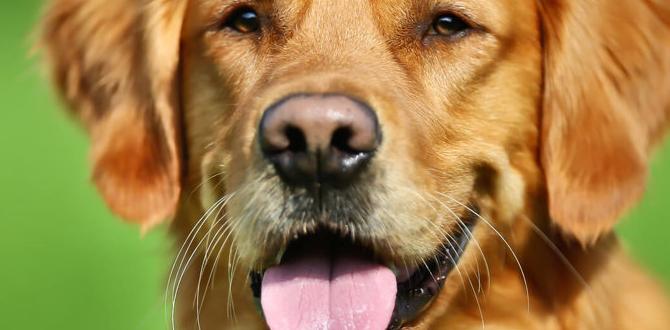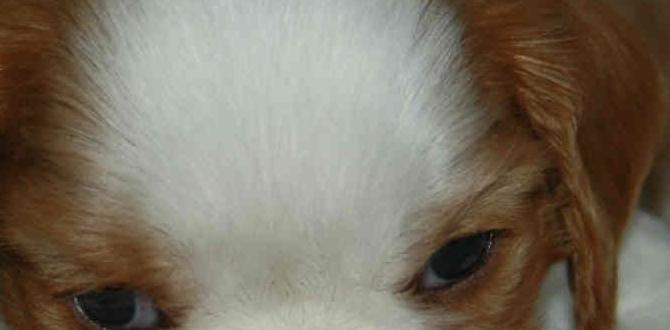Dealing with dog attention seeking in puppies is manageable! By understanding the root cause and implementing consistent, positive training methods, you can redirect your puppy’s behavior toward desired interactions, leading to a happier, well-behaved companion.
Is your puppy a little shadow, constantly nudging you, barking for attention, or bringing toys repeatedly? It can feel overwhelming when your furry friend seems to demand your attention non-stop! But don’t worry, this is a super common puppy behavior that many new pet parents experience. It often stems from your puppy trying to communicate and connect with you. It’s their way of saying “Hey, I’m here, and I want to play!” or “I need something!” Understanding why they do this is the first step to finding some peace and quiet – and strengthening your bond. We’ll walk through simple, effective strategies to help your puppy learn when and how to get your attention appropriately. Get ready to transform those demanding barks into happy, engaged moments!
Understanding Why Puppies Seek Attention
Puppies are bundles of energy and curiosity, and seeking your attention is a natural part of their development. They rely on you for everything – food, shelter, play, and affection. So, when they try to get your eyes and ears, they’re not trying to be “bad”; they’re just trying to fulfill their social and emotional needs. Understanding these motivations can help you respond with empathy and effectiveness.
Social Animals: The Pack Mentality
Dogs, and especially puppies, are inherently social creatures. In the wild, they live and thrive in packs. Your family is your puppy’s pack now. They want to be involved in everything you do and get your input. Attention from you reinforces their sense of belonging and security within the pack. This means your puppy will naturally try to engage with you to feel connected and part of the group.
Learning and Exploration
Puppies are constantly learning about the world around them. They observe your reactions and learn what gets them results. If a particular behavior, like a soft whine or a paw on your leg, results in you looking at them, petting them, or talking to them, they’ll repeat it! This is how they figure out how to interact with their environment, including their favorite humans. It’s a sign of their intelligence and their desire to understand their place in your home.
Boredom and Lack of Stimulation
Sometimes, attention-seeking behavior is simply an outlet for pent-up energy or a sign that your puppy is bored. When they don’t have enough outlets for physical activity or mental stimulation, they’ll find their own ways to entertain themselves – and often, that involves trying to get you involved. This can manifest as excessive barking, nipping, or destructive chewing if their needs aren’t being met.
Seeking Basic Needs
It might seem obvious, but sometimes your puppy is seeking attention because they genuinely need something. This could be because they need to go outside to potty, they’re hungry or thirsty, or perhaps they’re feeling a bit unwell or uncomfortable. Learning to distinguish these needs from simple attention-seeking is key to responsible puppy care.
Past Reinforcement
A critical factor is how we, as owners, have unintentionally reinforced these behaviors. If every time your puppy whines, you immediately give them a treat or a pet, they learn: “Whining gets me what I want!” This is classical and operant conditioning in action. It’s not your fault; it’s a learning process for both of you. The good news is that you can use the same principles to teach them better ways to ask for what they need.
Genius Solutions to Manage Dog Attention Seeking in Puppies
Now that we understand the “why,” let’s dive into the “how.” These strategies are designed to be positive, effective, and build a stronger relationship with your puppy. Consistency is your best friend here!
1. Proactive Engagement: Beat Them to the Punch
The best way to stop unwanted attention-seeking is to provide plenty of positive attention on your terms. This means scheduling dedicated playtime, training sessions, and cuddle times throughout the day. When your puppy has had their fill of positive interaction with you, they’re less likely to feel the need to demand it.
- Scheduled Playtime: Dedicate at least two to three short play sessions (10-15 minutes each) per day. Use a variety of toys to keep it interesting.
- Training Sessions: Short, fun training sessions (5 minutes) several times a day can be mentally stimulating and rewarding. Teach them new tricks or practice basic commands.
- Affection Breaks: When you’re relaxing, invite your puppy to snuggle. Offer gentle petting and praise.
- Supervised Interaction: When you’re busy, ensure your puppy has safe access to toys and a comfortable space. Periodically check in and offer a quick, positive interaction.
2. The Power of Ignoring (The “Nothing In Life Is Free” Approach)
This sounds harsh, but it’s incredibly effective for non-essential attention-seeking behaviors like excessive barking or pawing when they’ve already been fed, watered, and pottied. When your puppy barks, whines, or nudges you for attention, and you know their basic needs are met, you simply ignore them. No eye contact, no talking, no touching. Wait for a moment of quiet or a calm behavior before you acknowledge them.
- Wait for the Pause: The instant the barking or whining stops, or they settle near you, reward them with calm praise.
- Consistency is Key: Everyone in the household must follow this rule. If one person gives in, the puppy learns that persistence pays off eventually.
- Why it Works: You’re teaching your puppy that the disruptive behavior does not get them attention, while calm behavior does.
3. Redirect and Reward Desired Behaviors
When your puppy starts to engage in attention-seeking that you don’t want, gently redirect them to an acceptable behavior and then reward that. This is proactive training. For example, if they start to bark incessantly at you while you’re trying to work:
Instead of: Yelling at them or pushing them away (which can be a form of attention).
Try This:
- Calmly say, “Let’s play!” or toss a favorite toy nearby.
- If they go to the toy, praise and reward them.
- If they bring the toy back and drop it for play: great! Engage in a short game.
- If they continue to bark incessantly, you might need to use the ignoring technique for a short period before redirecting again.
This teaches them alternative, acceptable ways to get your attention and fulfill their need for interaction.
4. Teach a “Quiet” or “Enough” Command
This is a more advanced technique but incredibly useful. When your puppy is barking to get attention (and you’ve determined their needs are met and they aren’t in distress), let them bark a few times. Then, calmly say your chosen cue, like “Quiet,” and immediately present a high-value treat near their nose. Most dogs will stop barking to sniff the treat. As soon as they are quiet, praise them and give the treat. Repeat this frequently. Over time, they’ll associate the word “Quiet” with stopping their barking and earning a reward. You can later use this cue when they are being overly vocal.
A related command is teaching them to “settle.” When they are calm, you can use a cue like “Settle” and reward them for lying down quietly. This reinforces the idea that being calm also garners positive attention.
5. Provide Appropriate Outlets for Energy and Mental Stimulation
A tired puppy is a well-behaved puppy! Attention-seeking often stems from boredom or excess energy. Ensure your puppy is getting enough physical exercise appropriate for their age and breed, as well as mental challenges.
Physical Exercise:
- Age-Appropriate Walks: While young puppies shouldn’t have long, strenuous walks due to developing joints, short, frequent outings are great.
- Play Sessions: Fetch, tug-of-war (with rules!), and chase games are excellent.
- Secure Yard Play: If you have a safe, fenced yard, supervised free play can tire them out.
Mental Stimulation:
- Puzzle Toys: Food-dispensing toys like KONGs (stuffed and frozen for a longer challenge) or Nina Ottosson puzzles engage their minds.
- Training Sessions: Learning new commands or tricks is a fantastic mental workout.
- Nose Work Games: Hide treats around the house and let them sniff them out. This taps into their natural scenting abilities.
- Chew Toys: Provide a variety of safe and engaging chew toys.
The Companion Animal Psychology resource provides excellent insights into enrichment activities for dogs. You can find it at Companion Animal Psychology.
6. Establish a Routine
Puppies thrive on predictability. A consistent daily routine for feeding, potty breaks, playtime, training, and rest can significantly reduce anxiety and the need for attention-seeking. When your puppy knows what to expect and when, they feel more secure and are less likely to become desperate for your notice.
A sample routine might look like:
| Time | Activity | Notes |
|---|---|---|
| 7:00 AM | Potty Break & Short Play | First thing after waking |
| 7:30 AM | Breakfast | In their crate or feeding station |
| 8:00 AM | Training/Mental Game | Short, fun session |
| 9:00 AM | First nap | Ensure a quiet, safe space |
| 11:00 AM | Potty Break & Playtime | Longer play session |
| 12:00 PM | Lunch | |
| 12:30 PM | Potty Break | |
| 1:00 PM | Second nap | |
| 3:00 PM | Potty Break & Walk/Play | Tailor to energy levels |
| 5:00 PM | Training/Puzzle Toy | |
| 6:00 PM | Dinner | |
| 6:30 PM | Potty Break | |
| 7:00 PM onwards | Relaxation/Cuddle Time | Quiet wind-down |
| 9:00 PM | Last Potty Break & Bedtime |
Remember to adjust this based on your puppy’s individual needs, age, and breed. The key is consistency.
7. When to Seek Professional Help
While attention-seeking is typically a behavioral issue that can be managed with training, there are times when consulting a professional is beneficial. If the behaviors are extreme, persistent despite your best efforts, or if you suspect underlying anxiety or stress, a certified professional dog trainer or a veterinary behaviorist can provide tailored guidance.
A great resource for finding qualified professionals is the American Kennel Club’s (AKC) guide to finding a trainer.
Tips for Specific Attention-Seeking Scenarios
Let’s look at a few common scenarios and how to apply these principles.
Scenario 1: The Constant Nudger or Pawer
Problem: Your puppy continually nudges your hand with their nose or paws at you.
Solution:
- Ignore: Initially detach yourself. If they are physically pawing, stand up and walk away for 30 seconds.
- Redirect: When you return, offer them a favorite toy (e.g., a stuffed KONG, a chewy bone).
- Reward Calmness: Praise and pet them only when they are calm and not actively pawing or nudging. If they start again, repeat the ignore/redirect cycle.
- Teach “Trade”: If they offer you items to get attention, teach them to “trade” by offering a treat for the item, then calmly take it. This prevents them from hoarding things to get your attention.
Scenario 2: Excessive Barking for Play/Attention
Problem: Your puppy barks incessantly at you when they want to play or get attention.
Solution:
- Scheduled Playtime: Ensure they have enough scheduled play.
- “Quiet” Command: Practice teaching the “Quiet” command as described earlier.
- Ignore the Barking: Do not engage with them while they are barking. Don’t look, don’t talk, don’t touch.
- Reward Silence/Calmness: The moment they stop barking, even for a breath, praise them calmly. Then, you can initiate play or give affection.
- End Play if Too Much: If play sessions become over-arousing and lead to excessive barking, take a break.
Scenario 3: The “Bring Me This Toy NOW” Puppy
Problem: Your puppy drops a toy at your feet and barks or whines until you pick it up or play.
Solution:
- The “Drop It” Game: Teach a solid “Drop It” cue. When they bring you a toy, say “Drop It” and offer a high-value treat. When they release it, praise and give the treat.
- Ignore Demands: If they’re demanding play by dropping the toy and barking, ignore them.
- Initiate Play on Your Terms: Pick up the toy yourself later, or during a scheduled playtime. Say enthusiastically, “Wanna play fetch?” and throw it. They’ll learn that you control the start of the game.
- Toy Rotation: Rotate toys to keep them novel and exciting.
Common Pitfalls to Avoid
Even with the best intentions, some common mistakes can hinder progress:
- Inconsistency: This is the single biggest pitfall. If sometimes barking gets attention and sometimes it doesn’t, your puppy will keep trying!
- Punishment: Yelling, scolding, or physically punishing your puppy for attention-seeking can increase anxiety and damage your bond, often making behavioral issues worse.
- Giving In (Even Once): This can undo days of progress. It’s crucial that everyone in the household is on the same page.
- Not Meeting Basic Needs: Always double-check that your puppy isn’t hungry, thirsty, needs a potty break, or is in pain before assuming it’s just attention-seeking.
- Lack of Stimulation: An under-stimulated puppy will find ways to entertain themselves, often through unwanted behaviors that get your attention.
The Veterinary Partner website offers helpful articles on understanding and managing common puppy behaviors, including seeking attention. You can explore their resources at Veterinary Partner.
Frequently Asked Questions (FAQ)
Q1: My puppy barks constantly for attention. Will ignoring them make them anxious?
A1: Ignoring mild attention-seeking behaviors like barking (when all needs are met) is generally safe and effective. It teaches them that their vocalizations don’t get what they want, while calm behavior does. If the barking is excessive, frantic, or accompanied by other signs of distress, it might indicate underlying anxiety, and consulting a vet or trainer is recommended. The key is to ignore the behavior, not abandonment. You will still provide plenty of positive attention at appropriate times.
Q2: My puppy paws at me when I’m on my laptop. How can I stop this?
A2: When they paw, calmly remove their paw and try offering a puzzle toy stuffed with a treat to redirect their focus. If they continue, practice the “Nothing In Life Is Free” approach: stand up, walk away to another room for about 30 seconds, then return. When they are calm, you can engage with them briefly or give them the puzzle toy. Consistency is crucial.
Q3: What if my puppy tries to get attention by nipping my hands or feet?
A3: Nipping is often how puppies play and learn bite inhibition. If it’s attention-seeking, the immediate reaction should be to say “Ouch!” in a high-pitched voice and immediately cease all interaction – turn away, walk away. After a short break (10-20 seconds), you can calmly re-engage, perhaps by offering a suitable chew toy or starting a game. This teaches them that biting stops the fun.
Q4: My puppy used to be calm, but now they’re constantly demanding attention. What changed?
A4: This could be due to several factors: a change in routine, a growth spurt, adolescence kicking in (which can bring new levels of independence and testing boundaries), or because attention-seeking behaviors have been accidentally reinforced. Re-evaluate your routine, ensure adequate exercise and mental stimulation, and re-commit to consistent training, especially the “ignore” and “reward desired behavior” techniques.
Q5: How much focused attention does a young puppy actually need each day?
A5: It varies by breed and individual puppy, but puppies generally need significant social interaction. Aim for several short (5-15 minute) play or training sessions spread throughout the day, interspersed with naps. They also benefit from simply being in the same room as you, even if you’re not actively interacting. The goal is quality, positive interaction, not just constant contact.
Q6: Is it okay to give my puppy a treat just to get them to be quiet?
A6: Yes, this can be a part of teaching a “Quiet” command, but it’s important to do it strategically. You want to avoid rewarding every bark with a treat. Instead, wait for a brief pause in barking, give the cue (“Quiet”), then immediately offer the treat. This reinforces that stopping the barking leads to a reward. Over time, you fade the treat, relying on praise and continued quiet behavior.
Conclusion
Managing dog attention-seeking in puppies is a journey, not a race. It’s about understanding their developmental needs, being consistent with your training, and most importantly, building a strong, trusting relationship. By proactively providing attention on your terms, ignoring unwanted behaviors, and redirecting them towards positive interactions, you’ll not only curb the demanding habits but also foster a happy, confident, and well-behaved canine companion. Remember that every puppy is an individual, so be patient, celebrate the small victories, and enjoy the process of growing together. Your puppy is eager to please and learn; with these genius solutions, you’re well on your way to harmonious living!
Meet Elyse Colburn, the devoted canine companion and storyteller behind the enchanting world of “Tales, Tails, and Adventures Unleashed.” A passionate dog enthusiast with a heart full of paw prints, Elyse Colburn shares heartwarming tales and insightful adventures, celebrating the joy, loyalty, and endless antics that make every dog a true hero. Join Elyse Colburn on this tail-wagging journey, where every post is a love letter to our four-legged friends.





